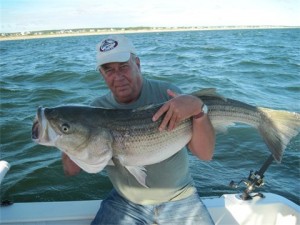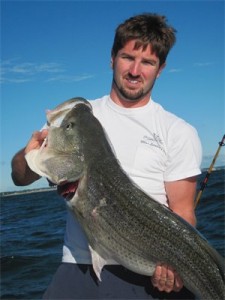Striped bass fishing can be a downright overwhelming task. Then again there are those days when the bass just seem to find the fishermen.
One particular trip during the middle of August 2010 could certainly be classified as one of those rare occasions when big striped bass are easy to come by.
The wind was howling out of the southwest at around 20 knots. I had the Miss Loretta cruising the shoreline when I noticed the first mark on the sonar. It was a nice fat orange blimp that could not be mistaken for anything other than a cow striper.
The tube and worm rigs quickly went into the water as I watched many more orange arches appear on the sonar screen. We were in business, and had found a considerably large school of stripers.
The cranking breeze was pushing the boat hard, and even with the engine in neutral our trolling speed remained above 4 knots. Traditional wisdom says tubes catch fish best if trolled at speeds less than 2 knots. However this trip would prove that tubes trolled at above average speeds can still produce impressive catches.

Bass after big bass came over the gunnels as we trolled in neutral, propelled by the breeze to the east. The wind had now increased to 25 knots, accelerating our troll and eastward drift.
The action finally died off a couple hours later, close to the SW tip of Billingsgate. We had trolled 6 miles directly east and had hooked up with at least one 15-40 pound bass every 10-15 minutes.
As I headed the bow west into the 3 foot chop, I wondered how we had managed to consistently hook up along the entire 6 mile trek.
Giant Schools of Striped Bass or a Lucky Coincidence?
It is fun to imagine that we had encountered a 6 mile long school of keeper stripers-however I do not believe this was the case. The logical explanation is that we found a biomass of stripers that were moving eastward at the same rate as our 4-5 knot troll.
Had we been trolling slower, or in a different direction, it is reasonable to theorize that we may have lost track of the large school of bass much sooner. We were lucky that the speed and direction of our troll coincided nicely with the movement of the biomass of fish.
Stumbling upon a school of big bass when striped bass fishing by complete chance does not occur often. We got lucky that day, however understanding the behavior of big striped bass played a major role in finding that biomass of fish in the first place.
Had we not already had an idea of a productive area and productive depth to begin our search, we would have missed out in a big way.
A Seasonal Influence on Large Striped Bass
Bass seem to behave differently depending upon the season. Having a general grasp of their seasonal patterns can help establish a starting point when fishing from a boat.
During the spring, many bass are more apt to frequent areas closer to shore. This is good news for the shore bound and boat striped bass fisherman. When large schools of bass move in along the beach, it is easier to locate the fish and remain with the fish by using sonar.
Typically my springtime bass trips will begin around the mouths of creeks, in channels, and close to the beach.
Once the middle of June rolls around, striped bass fishing techniques off Cape Cod can change as the vast majority of large bass abandon these shallow water haunts and retreat for the deeper water offshore. During the height of the summer, I will concentrate my efforts in 60-90 feet of water.
Of course there are exceptions, and on occasions we’ll find bass much shallower than 60 feet. However, when establishing a starting point, it makes sense to at least begin my search at a depth with the greatest probability of holding fish.

As the summer wanes into fall, the majority of big striped bass will once again begin congregating closer to shore, which makes boat fishing much easier and usually more productive.
It is a lot easier to stay on top of these shallow water bass, and it is possible to boat a lot of big fish in a considerably shorter amount of time than during the summer-when bass hold in the depths.
Thanks for reading! And be sure to share this post with your friends on Facebook and Twitter. I really appreciate your help growing this blog!
Take care,
Ryan

